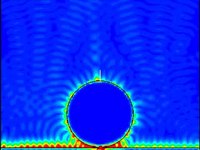
Photo from wikipedia
Computational modeling can provide a mechanistic and quantitative framework for describing intracellular spatial heterogeneity of solutes such as oxygen partial pressure (pO2). This study develops and evaluates a finite-element model… Click to show full abstract
Computational modeling can provide a mechanistic and quantitative framework for describing intracellular spatial heterogeneity of solutes such as oxygen partial pressure (pO2). This study develops and evaluates a finite-element model of oxygen-consuming mitochondrial bioenergetics using the COMSOL Multiphysics program. The model derives steady-state oxygen (O2) distributions from Fickian diffusion and Michaelis–Menten consumption kinetics in the mitochondria and cytoplasm. Intrinsic model parameters such as diffusivity and maximum consumption rate were estimated from previously published values for isolated and intact mitochondria. The model was compared with experimental data collected for the intracellular and mitochondrial pO2 levels in human cervical cancer cells (HeLa) in different respiratory states and under different levels of imposed pO2. Experimental pO2 gradients were measured using lifetime imaging of a Förster resonance energy transfer (FRET)-based O2 sensor, Myoglobin-mCherry, which offers in situ real-time and noninvasive measurements of subcellular pO2 in living cells. On the basis of these results, the model qualitatively predicted (1) the integrated experimental data from mitochondria under diverse experimental conditions, and (2) the impact of changes in one or more mitochondrial processes on overall bioenergetics.
Journal Title: International Journal of Molecular Sciences
Year Published: 2022
Link to full text (if available)
Share on Social Media: Sign Up to like & get
recommendations!